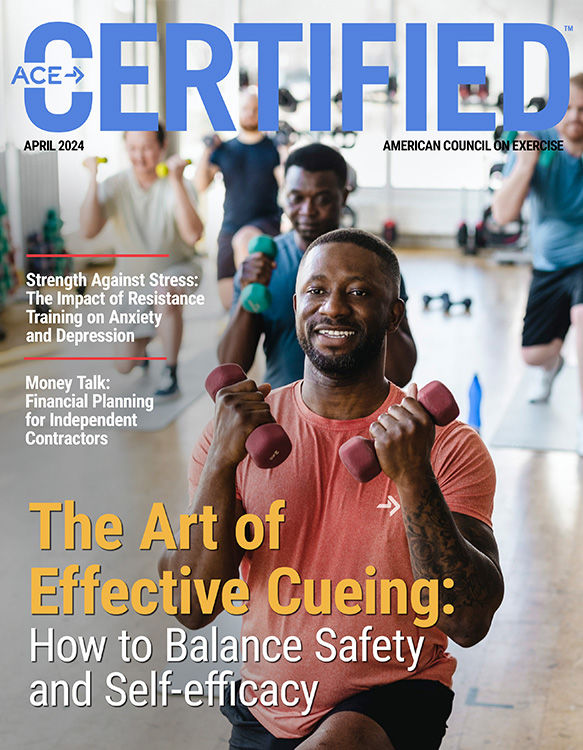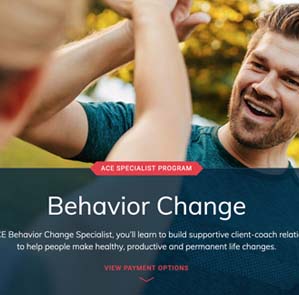
While many start off the new year by hitting the ground running (literally), by the time signs of spring arrive, chances are that initial excitement and motivation has dissipated to the point that many—perhaps your clients included—have abandoned their resolutions altogether. What can you do, as a health and exercise professional, to help your clients regain that motivational feeling and get back on track with their goals? Read on to learn a four-step process you can use with your clients to reinvigorate their vision of living a healthier life and tips for sticking with the pursuit of goals after the initial excitement wears off.
Step 1: Celebrate What Went Well (No Matter How Small)
When a client is unable to change a behavior over the long-term, it’s natural for them to dwell on all the reasons why there weren’t successful. This type of thinking keeps the focus on the negative aspects of the attempt rather than on the positive elements that can be carried forward into future lifestyle changes. But changing from an attitude of disappointment and failure to one of victory and celebration is no easy feat, especially if your client has an all-or-nothing mindset. The key is to help your clients recognize and celebrate what went well each time a change in behavior is made, as this can provide insights that guide and shape future behavior-change efforts.
First, it’s important to think small when celebrating what went well. While a client may not feel like celebrating because they did not stick with their resolution exactly how they had planned, encourage them to look for things that did go well, even if it was for only a month, a week or a day. Try asking your client “How were you able to be successful?” to identify moments worth celebrating. For example, let’s say a client set a goal to exercise three days per week for a year, but they only stuck with it for a few weeks. Obviously, they didn’t reach their goal, but what lessons can they learn from the weeks when they did exercise?
Here are some examples of how to find the positive in something that may have felt like a defeat:
|
Initial Thought
|
Positive Spin
|
What I Learned
|
|
I really messed up with portioning my food.
|
Even though I did not portion food the way I intended, my awareness of what and how much I am eating increased.
|
Now that I am more aware of what and how much I am eating, I need a quick and easy way to determine portion sizes.
|
|
So much for quitting smoking this year. I made it only five days and am right back at it.
|
I made it five days without smoking. I smoke one pack of cigarettes per day, and I was able to make it five days without a single cigarette.
|
During the days when I did not smoke, I kept busy by doing other things when I would normally be smoking. I smoke when I feel bored and stressed. What are other things I can do and how can I better manage my stress?
|
|
Walking every day seemed like the easiest way for me to increase my physical activity, but I only made it one month before giving up.
|
I went from walking on zero days per week to walking on seven days per week for a whole month! That is a huge increase.
|
Perhaps my goal was initially too big. Maybe going from zero to seven walks per week was too much. I think I will aim for three days per week. I was also much more likely to walk when I wore sneakers to work.
|
|
I really thought I could make time to write in my journal every day, but that did not last.
|
Even though I did not write in my journal daily, I did sleep better on the days I did.
|
Having my journal accessible made a big difference. I need to keep it with me. I might need a smaller journal that fits in my pocket or perhaps I can do an audio journal on busy days.
|
Step 2: Reconnect Goals With Values
At any point during a change journey, it is vital that clients stay focused on, or to tap into, their “why.” We often focus on making changes at the start of a New Year because we’re excited about the benefits that those efforts will bring. As time goes by, however, it is easy to lose sight of the reasons we wanted to change in the first place, especially if things aren’t going exactly as planned or the road to change is longer and bumpier than imagined. To move forward, begin by supporting clients in revisiting or establishing a new reason for why making a given change is important to them. Ask clients to respond to this question: “Why do you want to make this change?” Regardless of what their answer might be, it is important to ensure that their goals are meaningful and relevant to their unique values and their “why.” Encourage your clients to keep their “why” front and center, as it can be helpful when it comes to aligning their values with their actions.
Self-selected and appropriate goals that align with a person’s values and are personally meaningful may be easier to stay focused on over time, particularly once the initial excitement wanes. Two great ways to help clients keep their “why” in the spotlight throughout the year is to use imagery and daily reminders. For example, urge your client to imagine a scenario where they are making lifestyle changes because they would like to live as many healthy years as possible to be with their grandchildren. This client might take photographs of themselves with their grandchildren and place them in areas where they need the most reminding, such as on the refrigerator, where they keep their walking shoes, on the medicine cabinet, on the calendar or on the phone. They may also decide to add reminders to their calendar, such as “Go on a walk today—for my grandkids.” Encourage clients to remember their “why” and to remember it often.
Step 3: Evaluate and Adapt
Behavior change is an evolving process that includes tracking progress, overcoming struggles, adjusting goals and adapting action steps. Evaluating what is working and what isn’t and adapting goals and plans accordingly can be a crucial step when it comes to traversing the path toward goal attainment. As a health and exercise professional, you can assist in this process by creating a safe and supportive place during your client interactions for continual program evaluation to ensure that goals, action steps and systems of accountability are rooted in the client’s overall vision of the future. During the evaluation process, it may be beneficial to help clients develop an “experimental” mindset that lends itself to ongoing evaluation, testing of new ideas and integrating improved behavior-change redesigns along the way. Key areas to include during behavior-change evaluation include social support, the environment, and both real and perceived barriers. We’ll look at each of these in more detail below.
Social Support
Social support helps clients to feel connected to others during the behavior-change process. In fact, this element can make what feels like a socially isolated and lonely journey feel more like a group effort. Begin by working with clients to take a step back and looking at the goals they set for the new year. Next, ask them to think about the support systems they had in place for reaching their goals. Did the support they had meet their needs? If not, collaborate with your client to go about building better support into their behavior-change plan.
Here are some opportunities for social support that your client might consider:
- Let family, friends, neighbors and coworkers know about plans for behavior change and how they can best support them.
- Attend group classes.
- Recruit an exercise buddy.
- Connect with others in an online or in-person support group.
- Inform their healthcare team about the health-related goal they are working toward.
Having even just one person as a source of social support can lead to improvements in behavior change and having even more support can lead to greater change. Below is a table you can share with your clients that they can use to identify sources of support and develop a meaningful support system.
|
Sources of Support
|
What I Need From Them
|
|
Example: Coworkers
|
Example: Invite me to go on walks with them
|
|
|
|
|
|
|
|
|
|
Environment
A client’s environment can play a significant role in their ability to stick with a New Year’s resolution. Consider these scenarios to help better understand the role that your client’s environment can play.
Imagine your client has set a goal around joining and visiting a gym three times per week, but the nearest gym is 25 miles away. In this situation, your client may not be able to move closer to the gym to improve their environment, but they may be open to the idea of working remotely with an exercise professional to create an exercise program that can be completed at home.
Think about a person who has set a goal around increasing their intake of fruits and vegetables, but they do not regularly have fruits and vegetables in their home. Conversely, consider what might happen if this same person made a point of always having a variety of vegetables and fruits in the home. In other words, think about how you can empower your clients to restructure their environment for success. As a first step, ask your client to think about their current environment and considering what, if anything, can be changed. The following prompt can be particularly helpful: “How can you reshape your environment to best support the change you want to make?”
The following table can be used to explore opportunities for clients to change their environment to better support their goals:
|
Current Environment
|
Environmental Change
|
|
Example: Exercise equipment is hard to access at home.
|
Example: I will gather and prepare the equipment I need the night before and set it in place, so it is ready to go for home workouts.
|
|
|
|
|
|
|
|
|
|
Barriers
Examining barriers to change is another important step to take to keep moving forward on a journey of transformation. Exploring both real and perceived barriers can help clients develop a realistic plan to be prepared for obstacles they have already encountered and anticipate and prepare for what else might get in the way. This exercise can help to encourage action when faced with “in the moment” responses or decision making. Think of it as troubleshooting and problem solving—important tools for self-management and increasing resilience, which is the capacity to adapt and overcome challenges as they arise.
Here's a simple prompt you can use with your clients to explore barriers they may be facing: “What got in the way?” You may hear responses like travel, financial restraints, time, resources, knowledge and skills. Once a client has identified their barriers, you can begin the work of troubleshooting or preparing to overcome these obstacles when they arise. In the best-case scenario, a barrier can simply be removed; for example, a lack of knowledge barrier can be removed by providing a client with needed education or information. Other types of obstacles, however, such as financial restraints, cannot simply be removed. In these cases, you can help guide your clients in finding the means to do the best they can within the limits of their finances, time constraints, health or other situations. Use the following table with your client to start identifying barriers and brainstorming ideas for overcoming and doing their best should challenges arise.
|
Barrier
|
Ideas for Overcoming the Barrier
|
|
Example: I don’t have enough time to spend an hour at the gym.
|
Examples: Incorporating high-intensity interval training (HIIT) and/or activity snacking; learning more about how much time is needed for exercise to reap health benefits
|
|
|
|
|
|
|
|
|
|
|
|
|
|
|
|
|
|
|
Step 4: Formulate a Plan for Moving Forward
The final step in this process is to take everything your client has learned in steps 1 through 3 and work together to create a new plan for moving forward. Continue to encourage your clients to embrace an experimental mindset that focuses on learning from the experience and not simply on failure and success. It is much more effective to think in terms of making decisions about next steps based on what you now know about the realities of your client’s personal behavior-change journey and what they think they might need to be successful. Perhaps the new plan will include some of what went well from their initial resolution, while also building in some flexibility to overcome barriers that might get in the way.
At this point in your client’s behavior-change journey, they can use the table below to make progress on the behaviors they want to change. It also can be used at any time to test new ideas that may improve the consistency of their efforts. The idea is to work with your client to identify self-selected process goals (action steps) and see if they lead to the product goals they want to achieve. If they do, great! If not, reiterate and help them learn from where they have been and think about what next steps might lead to continuous improvement. Also, encourage your clients to think positively. Collaborate to identify positive or approach-oriented goals instead of avoidance-oriented goals to increase chances of successfully achieving what they set out to do. For example, instead of saying, “I will stop sitting around after work,” they could instead say something like “I will take a 20-minute walk in the evening after work.”
|
PROCESS
|
PRODUCT
|
|
Daily
|
Weekly
|
Weekly
|
Monthly
|
Yearly
|
|
30 minutes of physical activity
- Walk (20 minutes)
- Two activity snacks (5 minutes each)
5 serving of fruits and vegetables
|
Attend 2 group fitness classes
Go to the grocery store and purchase seasonal fruits and vegetables
|
Lose 1 pound
|
Lose 2 to 4 pounds
|
Lose 24 to 48 pounds
|
While setting resolutions can be a great way to add direction and purpose to the start of a new year, sticking with those goals as the year continues on can be challenging, no matter how important the behavior change may be to your client. Of course, goals can be set at any point in the year, regardless of what the calendar may say, and these often pose the same challenges related to maintaining motivation. The good news is that the steps outlined above can be used at any point during the year to help guide your clients back on track and reinvigorate their commitment to achieving their health and wellness goals.
Expand Your Knowledge
ACE Behavior Change Specialist Program
This program will help you familiarize yourself with common obstacles to achieving healthy behavior change and teach you how to help clients find their own path to a more fulfilling lifestyle. You will learn strategies, such as motivational interviewing and setting SMART goals, to help clients increase energy, prevent disease and develop healthier habits.
ACE Mover Academy Online – Course Bundle
If you missed the ACE Mover Academy Online virtual conference for exercise professionals and health coaches, we’ve brought the recorded sessions straight to you! Learn from our team of ACE experts and international presenters with this five-course bundle that delivers the latest evidence-based insights on coaching, cueing, orthopedic exercise, cardiorespiratory programming and more.
Building Healthy Habits Through Group Health Coaching
In this video training, learn how to run group coaching sessions and develop the skills you need to empower client motivation while building healthy habits within a community experience. Adding this unique skill set of group coaching to your current practice will help your clients navigate change and add a new dimension of growth to your business.





 by
by 





